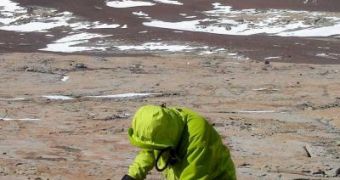The fossilized burrow found recently in Antarctica and dated to the Early Triassic epoch is thought to have belonged to tetrapods - land vertebrates with four legs or appendages resembling legs - and was created when a nearby river overflowed, filling it with fine sand that hardened later on. No remains of the animals inhabiting this burrow were found in the fossil, although there are tracks indicating that animals entered and exited it.
The burrow measures about 35.5 centimeters in length, 15.2 centimeters across and is found 7.6 centimeters bellow the surface.
"We've got good evidence that these burrows were made by land-dwelling animals rather than crayfish", said Christian Sidor from the University of Washington and assistant professor of biology and curator of vertebrate paleontology of the Burke Museum of Natural History and Culture, lead author of the paper detailing the discovery.
The burrow is said to be about 15 million years older than the tetrapod fossils found in Antarctica, in an area called Victoria Land. Fossilized burrows have been collected from the Fremouw Formation at Wahl Glacier and from the Lashly Formation at Allan hills towards the outer edges of Antarctica, during 2003 and 2005-2006 respectively, and although no fossilized bones were ever found inside them, Sidor believes that they might have been inhabited by small lizard-like reptiles or early mammals.
Some of the tetrapods found in Antarctica bear a striking resemblance to those found in South Africa, not very surprising since in the Triassic these continents were merged and were part of the Pangea supercontinent. Nevertheless, even at that time Antarctica was much cooler than other parts of Pangea and it's likely that the sea levels were somehow higher than today, which could account for the seeming lack of fossils dating from the Early Triassic.
"Everywhere has a spotty fossil record, but Antarctica has an extremely spotty fossil record because it is difficult finding exposed rocks amid all the ice", said Sidor.
Still, the temperatures were not low enough to allow the formation of ice, but the Antarctic area would have been significantly colder because the location where the burrows were found was already inside the Antarctic Circle.
"We have documented that tetrapods were burrowing, making dens in Antarctica, back in the Triassic. There are lots of good reasons for burrowing at high latitudes, not the least of which is protection from the elements.", he added.

 14 DAY TRIAL //
14 DAY TRIAL //